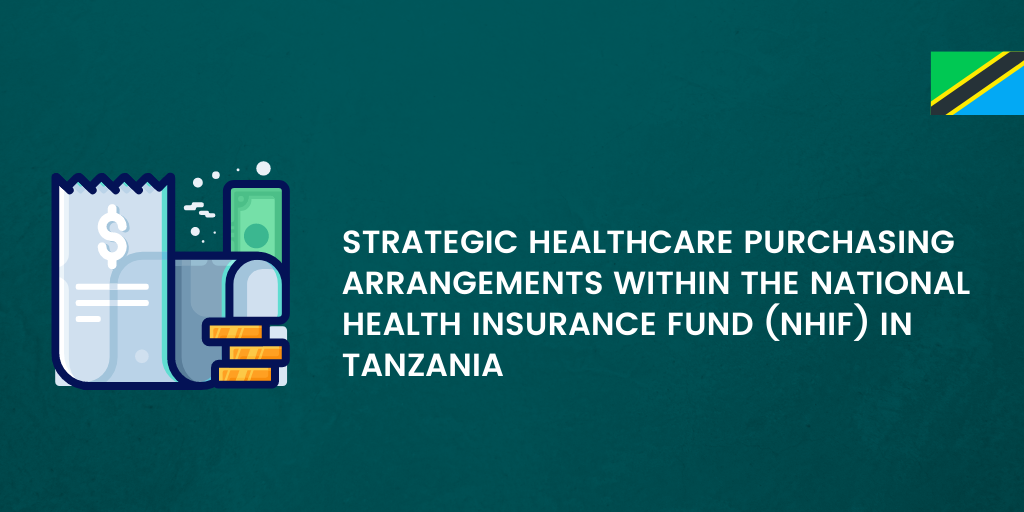Author: August Kuwawenaruwa
As many countries in Africa aim to achieve Universal Health Coverage (UHC), Strategic Health Purchasing has received growing attention in Tanzania, a low and middle-income country. Purchasing is among the three core functions of healthcare financing, where pooled revenue is allocated to health providers in return for the provision of healthcare services to the population based on their healthcare needs and priorities.
The Tanzanian government is committed to achieving universal health coverage (UHC) by ensuring that everybody has access to quality healthcare services and is protected against the financial risk that could arise as a result of paying for health care services. The National Health Insurance Fund (NHIF) is a social health insurance institution which has been applying ‘purchaser-provider split’ with the primary objective of ensuring accessibility of health care services to people.
The NHIF scheme in Tanzania was formulated through the NHIF Act CAP 395 and initially started with civil servants and later on expanded enrolment to the private sector, and more recently, private individuals who are willing and able to pay the premiums. Members employed in public and private sectors contribute to the Fund a total of 6 per cent of their basic monthly salary – equally shared between employer and employee. Premiums collected are pooled at the national level. As of June 2020, about 8 per cent of the Tanzanian population covering contributors and their beneficiaries was insured through NHIF.
I participated in an assessment of purchasing functions at NHIF, whose objective was to track general trends in strategic purchasing activities at the country level to inform country priorities for investment. The following questions guided the assessment: – are there explicit benefit packages, and how are the packages determined? Is there selective contracting with providers? What are the requirements to be contracted, and what is the process? What are the provider payment system(s) used to pay providers for health care services? How are provider payment rates determined? How is provider performance monitored? In this blog post, I present the purchasing arrangements and functions within the NHIF in contributing to knowledge on purchasing in public health insurance in Tanzania.
Benefits package
NHIF has an explicit benefit package offered to its members covering both outpatient and in-patient services based on the membership category. NHIF uses various platforms to inform improvements to the benefits package, create awareness, identify beneficiary needs and respond to beneficiary questions such as customer surveys, client service days, and public events such as the Dar es Salaam International Trade Fair (‘Saba Saba’) and the Agricultural Exhibition (‘Nane Nane‘). Also, providers give feedback/proposals to the NHIF management based on services sought at their facilities. NHIF beneficiaries have access to a 24-hour toll-free number staffed by the NHIF help desk in case of any complaints or suggestions. In 2019, membership categories and benefits packages were revised, and new benefits packages were established based on age, the number of dependants and the ability to pay the premium.
Contracting providers
NHIF has accredited more than 7,700 health facilities countrywide including dispensaries, health centres, district hospitals, regional referral hospitals, zonal referral hospitals, and national referral hospitals with a mix of ownership – public, faith-based and privately owned facilities. NHIF beneficiaries may access healthcare services in any NHIF accredited facilities. Also, the fund has accredited specialized clinics, stand-alone diagnostic centres, pharmacies in urban areas as well as Accredited Drug Dispensing Outlets (ADDO’s) in the rural areas. Accreditation may be initiated by NHIF or by providers requesting a contractual agreement with the fund.
Provider payment system
NHIF covers entitled services, and there are co-payments based on the membership category. NHIF provider payment rates are informed by actuarial analysis and are based on service provision assessments during accreditation, and sometimes through negotiation during the contracting process. NHIF uses fee-for-service set prospectively to reimburse accredited healthcare providers. Providers submit claims every month – both electronic and paper – to the nearest NHIF office where claims are audited by NHIF medical specialists, to ensure appropriate case management. Claims are validated by checking facility registers and in some cases, through client calls. In most cases, validated claims are paid within 30 days.
Medical equipment and facility improvement loan
NHIF has also been supporting health facilities in improving the quality of service provision as well as the environment through the provision of medical equipment loans and facility improvement loans. Several health facilities from primary to tertiary level facilities have benefited from this, and it has enabled them to provide services which were previously not available, and others have undergone rehabilitation to improve the quality of care to both NHIF members and other customers visiting facilities. An NHIF manager explained how loans work:
“…we have a project named facility improvement and equipment loan, where we lend to the facilities for either constructing a new building or renovating an existing building to improve the environment, as well as the purchase of the healthcare commodities that are needed at the facility to cater for the different needs of the scheme beneficiaries. We thereafter make some deductions from the facility monthly reimbursements for a certain duration of time. Many facilities have benefited through this process …”
Monitoring providers
The NHIF has been monitoring providers through quality assurance of clinical health services and service provision. NHIF Act section 26 has several clinical quality monitoring guidelines which providers have to comply with, and NHIF conducts regular health facility inspection to assess the quality of care provided to members. The NHIF uses an electronic system for registration, member and beneficiary verification, claims processing and referrals. NHIF actively monitors extra payment/co-payments charged to members by healthcare providers. When explaining how inspection and verification are conducted, the NHIF manager shared:
“…there are routine inspections conducted after reviewing provider’s claim forms. We verify whether the provider rendered services match the claim amounts and if the scheme beneficiaries received the services specified in the claim form...”.
Conclusion
The NHIF in Tanzania operates under the principles of risk-sharing and solidarity among members, however, there are concerns about financial protection and equity. For example with the new benefit packages which are categorized according to members’ ability to pay, well off members may be able to afford broader benefit packages with more services, whereas the members that are not well off have limited benefit packages. In addition, there are additional co-payments charged for certain services.
In some district, regional and referral hospitals, NHIF in consultations with the providers have set up “special NHIF wings” for NHIF members to access services with limited waiting time. In addition to the special wing, there are specific doctors assigned to NHIF beneficiaries. This creates some inequity as people insured by other schemes and uninsured individuals may not have access to the same level of care.
Despite these challenges, there are promising practices that can be borrowed from Tanzania’s NHIF such as the purchaser-provider split, accreditation process and selective contracting of healthcare providers to ensure access to services for members. The medical equipment and facility improvement loan has facilitated facility upgrades and service availability. Finally, NHIF has developed clear systems for monitoring quality to ensure their members are guaranteed access to high-quality health services and in this way contributing to Tanzania’s aspiration of attainment of UHC.
Biography:
MoHCDGEC, Tanzania Health Financing Strategy 2015-2025 Path towards Universal Health Coverage: Dar es Salaam, Tanzania.
NHIF, The National Health Insurance Fund Act, 1999. NHIF, Dar es Salaam, Tanzania.
SPARC, Strategic Purchasing Africa Resource Centre – Technical Partnership on Strategic Health Purchasing Progress Mapping, Cotonou, Benin. 2020
URT, United Republic of Tanzania Ministry of Health and Social Welfare: Health Sector Strategic Plan July 2015 – June 2020 (HSSP IV) Reaching all Households with Quality Health: (HSSP IV) Reaching all Households with Quality Health Care. 2015: Dar es Salaam, Tanzania

ABOUT THE AUTHOR
August Kuwawenaruwa is a research scientist at the Ifakara Health Institute (IHI). He has extensive experience in the economics, healthcare financing and impact evaluation of healthcare intervention. August holds MA in Economics from University of Dar es Salaam, Tanzania and is completing a PhD in Public Health at the University of Basel – Basel – Switzerland. His research interests in economics include health financing, equity in health, cost-effectiveness analysis, maternal and child health, complimentary pharmaceutical supply chain, and recently, the strategic healthcare purchasing.

